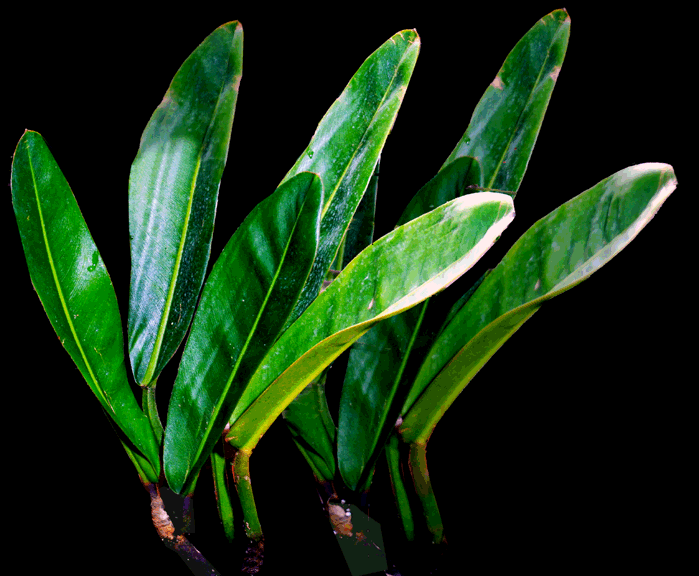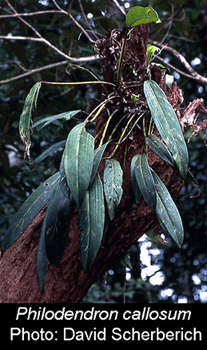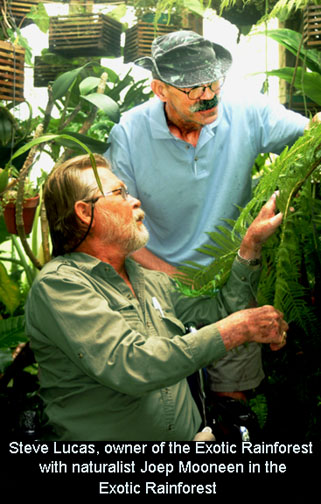![]()
Aroids and other genera in the Collection
Take the Tour Now?
Orchids
The
Exotic Rainforest
Plants in
the Exotic Rainforest Collection
Images on this website are copyright protected. Contact
us before attempting to reuse.
In depth information on how to grow Philodendron species, Click Here
Within our collection we have many species of Philodendron. If you are seeking other photos, click this link

Philodendron callosum K. Krause
Described to science in 1913, Philodendron callosum is found in Venezuela, the Guiana Shield, and northwestern Brazil, P. callosum is largely found as an epiphytic species growing on dead trees. epiphytes (ep-a-FIT) are those plant species that grow attached to another plant, in most cases a tree. But the epiphytic Philodendron callosum is botanically in a section of species that commonly grow on the ground and even on stone. That Philodendron section is Philiopsammos.
Almost all specimens in this
section are limited to the Guiana Shield and the Amazon region near that part of
northeastern South America. Rather than growing as epiphytes, species in sect.
Philiopsammos are largely terrestrial or epipetric. Epipetric species are those
that grow on stone. Section Philiopsammos includes approximately one dozen
species, almost all are known to creep across the
ground.
One common factor to species within this section is these Philodendron
possess short internodes. An internode is defined as the portion of
stem between the plant's nodes.
The nodes are the places along a stem
where leaves are placed. Although Philodendron callosum is
placed botanically in this
 section it tends to grow in the rain forest on dead
trees as an epiphyte.
Philodendron species, and especially hybrid forms, are
known to be highly variable and not every leaf of every specimen
will always appear the same. This link explains in greater
detail the scientific principle of natural variation and
morphogenesis.
Click
here.
section it tends to grow in the rain forest on dead
trees as an epiphyte.
Philodendron species, and especially hybrid forms, are
known to be highly variable and not every leaf of every specimen
will always appear the same. This link explains in greater
detail the scientific principle of natural variation and
morphogenesis.
Click
here.
Dutch naturalist Joep Moonen (pronounced yupe) works in the rain forests of the Guiana Shield and
lives in French Guiana. French Guiana is a relatively small country in the
northeastern portion of the South American continent which bs on the
Atlantic Ocean to the north and Brazil to the south. In an email received
in November, 2007 Joep indicated Philodendron callosum is quite rare
within the region and is a
"Nice small epiphyte with extra
ordinary leaf surface tissue. (It
is) Not common."
He continues in his brief note
saying the species "loves
to live on dead trees and feeds on the dead bark".
Later in the same message Joep stated P. callosum lives well
"under ideal circumstances
(with) lots of humidity
and food (dead bark),
grows well in direct sunlight
and makes compact beautiful leaves."
It also "grows in the
shade hanging on the trunks of living trees
(growing)
relatively long dark green
leaves." Joep also stated P.
callosum is not often found in flower in the rain forest. He pointed out,
like some other epiphytes, the species does not grow well in a pot with plant
soil. He is actually considering attempting to grow it strictly in sawdust.
 When
a Philodendron species is "in flower", the term is not used the same way
as if one were speaking of a bed of perennial or annual flowers. The
"flowers" on a Philodendron are quite small, almost microscopic.
Aroid expert Julius Boos explains,
"What usually is referred to as
a flower on an aroid actually is a complex or combination of several different
structures, and is referred to as an inflorescence. The spathe is actually just
a modified leaf, sometimes attractively colored, which surrounds and protects
the spike-like central spadix. The true and usually tiny flowers are located
along the spadix."
When
a Philodendron species is "in flower", the term is not used the same way
as if one were speaking of a bed of perennial or annual flowers. The
"flowers" on a Philodendron are quite small, almost microscopic.
Aroid expert Julius Boos explains,
"What usually is referred to as
a flower on an aroid actually is a complex or combination of several different
structures, and is referred to as an inflorescence. The spathe is actually just
a modified leaf, sometimes attractively colored, which surrounds and protects
the spike-like central spadix. The true and usually tiny flowers are located
along the spadix."
Philodendron species are a uni-sexual genus. Julius explains it
best regarding Philodendron species,
"The male and female flowers are
situated in different areas, the female at the base of the spadix, then sterile
flowers, then above them are the male, and in some species there is also a
sterile zone at the top of the spadix."
Many Philodendron species are pollinated by a very specific insect
"assigned" in nature to fulfill that purpose. Mother nature uses these
"assigned" insects to prevent cross pollination within a species and keep the
species relatively pure. Those "assigned" to pollinate a specific species
are normally the males of the insect species and are drawn to the plant by a
type of "perfume" known as a pheromone. And in the case of Philodendron
callosum, that insect species is known by botanists and entomolostists to be
pollinated by a scarab beetle known scientifically as Cyclocephala rustica.
There are at least three known variations (forms) of Philodendron callosum.
But even though P. callosum does grow in nature primarily as an epiphytic
species, it can and does grow on the ground. In fact, the majority of collectors
prefer to grow the species as a ground spreading species. And
despite the fact you can find references on the internet that indicate P.
callosum is now "wild" within the Hawaiian islands, Hawaiian native, grower,
and author Leland Miyano, who is an expert in aroids, palms, and cycads, made
these observations regarding the species,
"Philodendron callosum is not
wild in Hawaii, but it grows well. There are three forms that I grow. There is
the French Guiana form that is slightly rough, semi-coriaceous,with acuminate
tips, and medium green blades. There is the Venezuelan form that is the most
attractive in my opinion...dark green, very rough, rounded tips, and stiffly
coriaceous. The other form is Philodendron callosum var. ptarianum, which was
described as Philodendron ptarianum...oddly Kew accepts both names. It has
leathery glaucous blades that are smooth. I grow mine as terrestrials in
dirt...but it would grow as an epiphyte or on rocks as long as it is kept
slightly moist."
In a separate message, Leland commented
further about the species possibly thought by some in Hawaii to be
Philodendron callosum when he indicated perhaps the messages on the
internet "is mistaking
Elahoglossum ferns for the Philodendron. The common name is Maui's Paddle and
Philodenron callosum has a similar paddle-shaped leaf. Specifically,the endemic
species, Elaphoglossum crassifolium ( Gaudich.) W.R. Anderson & Crosby, has
thick coriaceous leaves and grows as an epiphyte or terrestrially."
At present, we grow our specimen, which was a gift from Florida collector
Christopher Mink, in extremely loose soil. The soil mixture is composed of
approximately
30% soil,
20% peat, 40% orchid bark with charcoal , 10% Perlite and some finely
cut and shredded sphagnum moss works well.
We also make our own compost and
add it in place of some of the peat when available. This
mixture is based on the fact this species appears to do best, at least in the
rain forest, as an epiphyte with its roots exposed to the air. This very
loose mixture allows even more exposure to the atmosphere than would a mixture
that stays constantly wet. The mixture is kept damp, but never wet.
However, we are seriously considering transferring our specimens into a large
30cm (12 inch) square wooden orchid box packed around the edges with sphagnum
moss and filled completely with orchid potting medium.
If you enjoy spending time in a rain forest filled with exotic
creatures and extremely rare exotic plant species Joep Moonen (pronounced yupe) also enjoys introducing
people like you to the
rainforests of northeast South America. The
Emerald Jungle Village website can be found at:
http://home.planet.nl/~gumamaus/
For eco-tour information and a
brochure contact Joep Moonen (pronounced yupe)
directly at
EmeraldJungleVillage@wanadoo.fr
My thanks to botanist David Scherberich, Jardin Botanique de la Ville de Lyon, Parc de la Tete d'Or, France for the use of his photograph of Philodendron callosum photographed in French Guiana. For those, like me, that don't speak French. That is the Botanical Garden of Lyon, France.
Specimens may be available
from
Brian's Botanicals
http://www.briansbotanicals.net/

If
you are seeking information on other rare species, click on "Aroids and other genera in the Collection" at the top and look for the
Want to learn more
about aroids?
Join the
International Aroid Society:
http://www.exoticrainforest.com/Join%20IAS.html